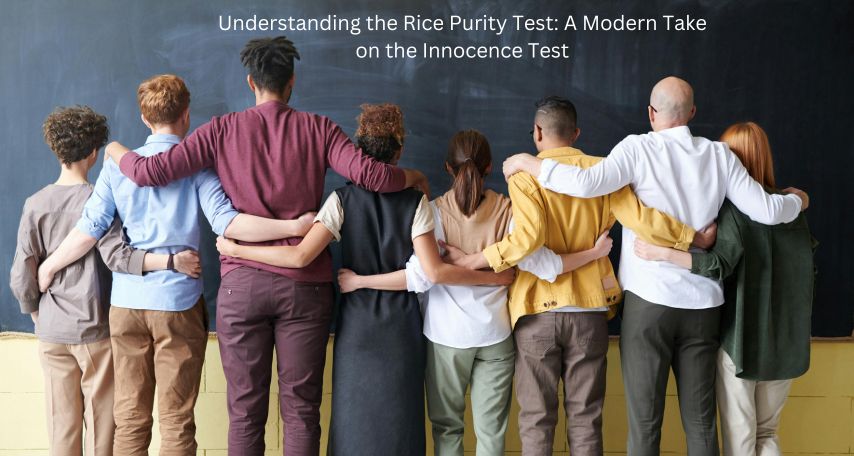· Tara Price · Trending
Understanding the Rice Purity Test: A Modern Take on the Innocence Test
![<p>The Rice Purity Test, a self-administered survey designed to measure an individual’s moral and social boundaries, has garnered significant attention since its inception at Rice University in the 1920s. Comprised of 100 yes-or-no questions, the test covers a broad spectrum of topics ranging from relationships and personal experiences to behaviours, including aspects of sexual behaviour, thereby acting as […]</p>](/_image?href=https%3A%2F%2Fneonmusic.online%2Fwp-content%2Fuploads%2F2024%2F04%2F444-2-39.jpg&w=900&h=506&f=webp)
The Rice Purity Test, a self-administered survey designed to measure an individual’s moral and social boundaries, has garnered significant attention since its inception at Rice University in the 1920s.
Comprised of 100 yes-or-no questions, the test covers a broad spectrum of topics ranging from relationships and personal experiences to behaviours, including aspects of sexual behaviour, thereby acting as both a purity test and an innocence test.
With scores calculated on a 0–100% scale—where a lower score suggests a more ‘pure’ or conservative stance—the Rice Purity Test serves not only as a benchmark for personal self-assessment but also as a conversation starter among peers, offering insights into the varied dimensions of one’s experiences and choices.
Despite its original purpose as a bonding tool for new students, the Rice Purity Test has evolved, inciting debates over its implications and the moral values it espouses.
Critics have voiced concerns about its explicit content and potential to reinforce negative stereotypes and slut-shaming.
Meanwhile, supporters argue for the test’s role in promoting self-reflection and meaningful discussions.
This dichotomy underscores the complex landscape of interpreting one’s rice purity score, what a rice purity test entails, and its significance.
As this article unfolds, it will delve deeper into the origin, purpose, and cultural impact of the Rice Purity Test, alongside a nuanced examination of the controversies surrounding these so-called measures of ‘purity’.
The Origin and Purpose of Purity Tests

Purity tests, including the widely recognised Rice Purity Test, have their roots deeply embedded in cultural rituals and social bonding activities, originating as tools for self-assessment and peer interaction.
The Rice Purity Test, developed at Rice University in the early 1920s, was initially a method for students to bond and discuss personal experiences in a structured way.
It has since evolved into a broader cultural phenomenon, often seen as a rite of passage among college students.
This test comprises 100 questions that delve into various life experiences, primarily focusing on topics related to sexual behaviour, drug use, and other adult activities, reflecting on one’s “purity” or innocence.
The evolution of purity tests from simple bonding activities to complex social phenomena highlights their role in fostering community and initiating conversations about personal values and experiences.
The Rice Purity Test, for instance, is not just about determining innocence but also serves as a platform for discussing and normalising a wide range of human experiences.
It encourages self-reflection and can lead to meaningful discussions about personal boundaries and societal norms.
Despite its original intent, the test has been critiqued for potentially reinforcing negative stereotypes and contributing to a judgmental culture, though it remains a popular and influential tool in college settings.
Over the years, the format and content of purity tests have seen various iterations and expansions, reflecting changing societal values and norms.
The Unisex Purity Test, first penned in the 1980s at MIT, is another example, illustrating the adaptability and enduring appeal of purity tests.
These tests often cover a wide array of topics, from alcohol consumption and illicit substance use to sexual acts and illegal activities, providing a comprehensive snapshot of an individual’s experience spectrum.
The continued popularity and adaptation of these tests underscore their significant cultural impact and the human interest in self-evaluation and peer comparison.
The Transition to the Innocence Test

The evolution of the Rice Purity Test into what is now often referred to as the Innocence Test marks a significant shift in the cultural landscape of self-assessment tools.
Originating on TikTok in 2021, the Innocence Test adapts the traditional format to include modern and rebellious activities, particularly those involving technology.
Unlike its predecessor, which focused more on purity, this modern iteration uses its framework to spark discussions among peers about personal growth and experiences.
The scoring of the Innocence Test also deviates from traditional purity tests.
Here, a lower score indicates a person’s openness to a broader spectrum of experiences, suggesting a more adventurous and less conservative lifestyle.
Conversely, a higher score points to a more reserved set of experiences.
This scoring system not only serves as a measure of one’s exposure to various life situations but also impacts the individual’s self-perception and confidence.
Furthermore, the results from an Innocence Test are not just numbers but tools for deeper self-reflection.
They encourage individuals to think critically about their life choices and experiences.
However, it is crucial to approach these scores with ethical considerations to prevent any potential misuse or harmful interpretations that could affect social interactions.
This ethical mindfulness ensures that the test remains a positive instrument for personal insight and community engagement.
How to Do TikTok’s ‘Innocence Test’

To take this version of the Innocence Test, follow these steps:
- Go to the website.
- You’ll see a list of 100 activities, such as ‘slid into someone’s DMs’ and ‘been on a date.’
- Tick the box next to each activity that you’ve done.
- After ticking all the relevant activities, click ‘Calculate my score’ at the bottom of the page.
- This will take you to the results page, where it will display your score and provide a brief description of what your score means.
To share your results on TikTok:
- Take a screenshot of the results page to save it to your camera roll.
- Open the TikTok app and create a new video.
- Use the ‘Upload’ feature to add the screenshot from your camera roll to the video.
Your Innocence Test results can now be shared on TikTok within your video.
Analysing Questions and Themes

Questions and Scoring System
The Rice Purity Test consists of 100 straightforward yes-or-no questions that explore various life dimensions, including relationships, intimacy, substance use, and legal issues.
These questions are designed to measure a participant’s level of exposure to diverse experiences, with the scoring system reflecting this exposure.
Scores range from 0 to 100, where a higher score indicates greater purity and a lower score suggests more varied life experiences.
The scoring categories are distinctly outlined, from “as pure as gold” for scores between 100 and 98 to “as corrupt as they come” for scores between 8 and 0, providing a broad spectrum of purity assessment.
Themes Explored in the Test
The test covers a wide range of themes, from innocent activities like holding hands to more contentious issues such as drug use and criminal behaviour.
This breadth allows the test to serve as a comprehensive reflection of one’s personal history and behaviours, touching on areas such as dating, substance abuse, and encounters with the law.
It also delves into childhood experiences, media consumption, and adult experiences, providing a holistic view of an individual’s moral and social boundaries.
Societal Implications and Critiques
Despite its initial purpose as a bonding tool, the Rice Purity Test has significant societal implications, often perpetuating judgements and stigmas around certain behaviours.
The lower scores can lead to feelings of shame and a negative self-image, which highlights the test’s impact on personal and societal perceptions.
Furthermore, the test has been critiqued for its potential to make some individuals uncomfortable due to the personal and invasive nature of some questions.
This underscores the complex role the test plays in modern social settings, where it continues to foster discussion yet also challenges individual privacy and societal norms.
The Role of Social Media in Propagating These Tests

Social media platforms significantly influence young individuals, often exposing them to content that may contradict traditional and family-oriented values.
This exposure can lead to a dilution of innocence as young minds, highly absorbent like sponges, take in these societal influences without a strong moral foundation.
The pervasive nature of social media often reinforces the more negative aspects of culture, such as cynicism and hostility, while stifling the spread of positivity and constructive interactions.
The environment on social media can be overwhelming for those with a more innocent or positive outlook.
It frequently serves as an echo chamber where anger, insults, and arrogance are amplified, making it a challenging space for individuals who wish to share kindness and positive thoughts.
This can lead to feelings of intimidation or disgust, causing some to retreat from social media platforms altogether.
Furthermore, the prevalence of negative interactions on these platforms can make well-meaning individuals feel that their positive contributions are futile against the overwhelming tide of negativity.
To navigate and possibly counteract this environment, several proactive steps are suggested.
Individuals are encouraged to actively praise others, build bridges, and strengthen community bonds.
Sharing personal experiences can foster positive feedback loops that encourage kindness and support.
It is also advisable to avoid unnecessary debates and to identify and steer clear of interactions with habitually angry individuals to minimise conflicts.
Calling out those who consistently tear others down and defending those who are vulnerable can also contribute to a more positive social media environment.
Lastly, showing righteous anger to defend truth and correct wrongs is crucial to maintaining ethical standards online.
Critique and Controversy Surrounding ‘Purity’ Measures

The Societal and Psychological Impact of the Rice Purity Test
The Rice Purity Test, while often seen as a harmless tool for self-reflection and social bonding, has faced significant criticism for its potential to reinforce negative stereotypes and societal norms.
Critics argue that the scoring system can lead to feelings of shame, self-hatred, and a negative self-image, as individuals may feel judged or labelled based on their scores.
This aspect of the test underscores the problematic nature of associating a numerical score with moral and personal worth, which can result in uncomfortable comparisons and judgements among peers.
Cultural Sensitivity and Privacy Concerns
Further, the test has been criticised for its lack of cultural or personal sensitivity and for the privacy concerns it raises.
The personal and invasive nature of the questions can make some individuals uncomfortable, highlighting significant privacy issues.
The test’s focus on sexual behaviour and other intimate details without considering cultural diversity and personal privacy preferences can alienate and distress participants, questioning the appropriateness and inclusivity of such tests.
Relevance and Validity of Purity Tests
Moreover, the relevance and scientific validity of the Rice Purity Test have been called into question.
Critics argue that it is an outdated concept that does not accurately reflect an individual’s character or worth.
The test is not officially recognised or endorsed by any institution, and the interpretation of scores varies with no universally accepted guidelines, further diminishing its reliability and relevance in assessing one’s character or experiences.
Supporters of the test suggest that it can foster open conversations about personal experiences; however, the arbitrary nature and the encouragement of harmful stereotypes challenge this perspective.
Conclusion
Throughout the exploration of the Rice Purity Test and its modern iteration, the Innocence Test, we’ve delved into their origins, purposes, and the controversies they spark in modern discourse.
These tests highlight a fascinating intersection between personal self-assessment and the broader cultural implications of what purity and innocence mean in today’s society.
While originally intended for bonding and self-reflection, these tests also provoke important conversations about privacy, societal norms, and the impact of categorising experiences through a numerical score.
It’s clear that while they serve as tools for introspection and community building among peers, they simultaneously raise critical questions about the ethics of such measures and their relevance in a diverse and evolving cultural landscape.
The ongoing debate around these purity measures underscores a crucial societal dialogue on self-identity, morality, and the inherent value of experiences.
As we navigate the complexities of modern life, tests like these prompt us to reflect on our actions, choices, and the broader implications of our personal narratives within social contexts.
While they may continue to be a source of curiosity and a means for reflection, it’s imperative to approach their results with a critical mind and an understanding of their limitations.
Ultimately, the significance of these tests lies not in the scores they yield but in the conversations they inspire and the introspective journey they facilitate, encouraging a more inclusive and nuanced understanding of purity and innocence in today’s world.
You might also like:
- How to Find Your Perfect Match with the Smile Dating Test
- Embracing Your Smile: Natural Ways to Soften Smile Lines
- Situationship Meaning: An Exploration into Modern Relationships
- Beyond the Lines: How to Use Smooth Rizz to Spark Genuine Connections
FAQs
1. What does a high score on the Rice Purity Test indicate about innocence?
A high score on the Rice Purity Test, specifically between 100 and 90, suggests that you are exceptionally innocent. This range is often interpreted as having a pure and golden heart.
2. How is a score of 79 interpreted on the Rice Purity Test?
A score of 79 on the Rice Purity Test places you within the range of 77 to 93, which is considered average in terms of purity. This suggests you’ve likely experienced love. Scores between 76 and 45 indicate less innocence, typically involving more extensive experiences related to disobedience, drug use, or legal issues.
3. What does a score of 45 mean on the Rice Purity Test?
A score of 45 on the Rice Purity Test falls within the range of 76 to 45, indicating significant exposure to activities such as drug use, sexual experiences, or encounters with the law. This score suggests a considerable departure from innocence.
4. How is the innocence test administered?
The innocence test, or Rice Purity Test, consists of 100 questions that require a “yes” or “no” response. These questions cover various life experiences, from romantic relationships to substance use. The principle behind the test is straightforward: the fewer experiences you’ve had, the higher your score and the more innocent you are considered.








